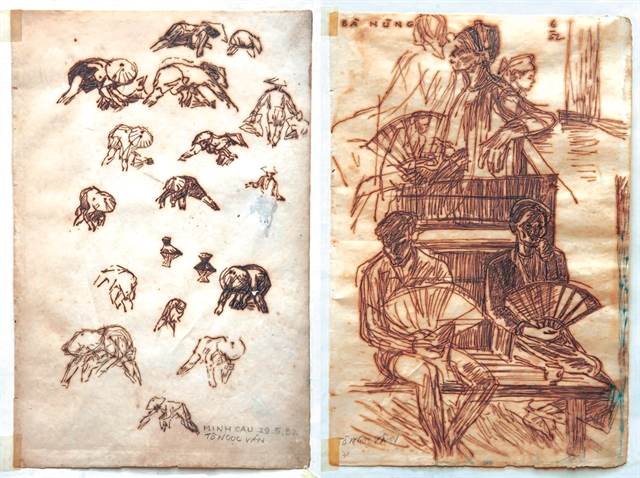
The most notable sketches by Tô Ngọc Vân are displayed at the exhibition. Photo courtesy of the organisers
HÀ NỘI Seventy-one artworks by the late master painter Tô Ngọc Vân are being showcased alongside pieces by seven contemporary artists in an exhibition that bridges generations of Vietnamese fine arts in Hà Nội.
The exhibition, entitled Hình Vang Vọng Ý (Figuring a Shape), creates a visual dialogue between Vân’s creations and works by Kim Bạch, Đặng Xuân Hòa, Phan Cẩm Thượng, Duy Hòa, Triệu Phương, Lê Thúy, and Xuân Lâm.
Tô Ngọc Vân (1906–54) is regarded as a monumental figure in Vietnamese fine arts, remembered not only as an artist but also as a thinker and educator whose influence continues to this day.
A top graduate of the second intake of the l'École des Beaux-Arts de l’Indochine (The Indochina School of Fine Arts) from 1926 to 1931, he quickly won recognition for his strong technique and sharp conceptual eye, especially in depicting the dynamism of Hà Nội’s urban life.
His oils, lacquer and silk paintings brought him fame before the 1945 August Revolution for national independence, and he became a pioneering figure in creatively assimilating Western artistic methods with Vietnamese traditions. Fifty-nine of his works are held in the Việt Nam National Fine Arts Museum’s permanent collection.
Following the outbreak of the First Indochina War in 1946 and the closure of the School of Fine Arts, a four-year course was held in the Resistance Base in Northern Việt Nam from 1950 to 1954 with 22 students under his instruction. Alongside painter Nguyễn Đỗ Cung (1912–1977), he helped lay the foundations for the country's theory and criticism of arts. He died aged 48 en route to Điện Biên Phủ battlefield.
Vân was later recognised as one of eight outstanding Vietnamese painters to receive the Hồ Chí Minh Prize for Literature and Art and the Independence Order in 1996.
“We aim to construct an hypothetical cross-generational dialogue between Tô Ngọc Vân and contemporary artists,” said curator Ace Lê. “all of whom are descendants of his school -- ranging from Kim Bạch to Xuân Lam – through a cross-section of their practices.
“Whether working in oil, lacquer, silk, paper or mixed media, these artists share a kinship with or draw inspiration from Tô Ngọc Vân’s approach, clearly evidenced in his own sketches.”
Born in 1938, Kim Bạch studied at the Kyiv National Academy of Fine Arts in Ukraine. She spent nearly four decades teaching at the Hà Nội University of Industrial Fine Arts (1967–1993) and later chaired the Art Council of the Việt Nam Fine Arts Association (1990–1999).
The youngest participating artist, Xuân Lam, draws inspiration from folk painting, historical archives, popular culture, and art history. He holds a master’s degree in painting from the Rhode Island School of Design and is known for revitalising traditional art forms with unique combinations of traditional techniques and digital graphics.
Phan Cẩm Thượng is a prominent cultural critic and scholar whose academic and artistic work over four decades has helped preserve national cultural identity.
His publications include Đồ hoạ cổ Việt Nam (Ancient Vietnamese Graphics, 2000), Nghệ thuật ngày thường (Everyday Art, 2008, 2018) and Văn minh vật chất của người Việt (Material Civilisation of the Vietnamese People, 2011).
The exhibition is open from 9am to 8pm until November 2 at 67 Tô Hiến Thành Street. VNS